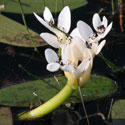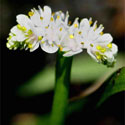|
Genus: Aponogeton (wateruintjies)
Life
> eukaryotes >
Archaeoplastida >
Chloroplastida
>
Charophyta > Streptophytina > Plantae (land plants)
> Tracheophyta (vascular plants) > Euphyllophyta > Lignophyta (woody plants)
> Spermatophyta (seed plants) > Angiospermae (flowering
plants)
> Monocotyledons > Order: Alismatales
> Family: Aponogetonaceae
Forty-three species, native to tropical to temperate regions of
Asia, Africa, Madagascar and Australia. Eleven species are native to southern
Africa.
Plants grow in freshwater with leaves floating on the
surface.
Species native to southern Africa
List from
Plants
of Southern Africa - an Online Checklist (SANBI),
Flora of
Zimbabwe and
Flora of Mozambique.
Aponogeton afroviolaceus
Recorded from Zimbabwe. See
Flora of Zimbabwe. |
|
Aponogeton angustifolius
A Western Cape endemic. |
|
Aponogeton azureus
Endemic to Namibia. |
|
Aponogeton desertorum
Occurs in Namibia, Zimbabwe, Botswana, Mozambique, Limpopo, North West
Province and Eastern Cape. See
Flora of Zimbabwe. |
|
Aponogeton distachyos
(Cape Pondweed)
A Western Cape endemic. The flowers are harvested as a vegetable. |
 |
Aponogeton fugax
Occurs in the Northern Cape and Western Cape. |
|
Aponogeton junceus
Widespread in southern Africa. See
Flora of Zimbabwe. |
 |
Aponogeton natalensis
Occurs in Limpopo, North West, Gauteng, Mpumalanga, KwaZulu-Natal, Eastern
Cape.
|
|
Aponogeton ranunculiflorus
Occurs in KwaZulu-Natal and Limpopo |
|
Aponogeton rehmannii
Occurs in Namibia, Zimbabwe, Botswana, Limpopo, North West, Gauteng, Mpumalanga and
Free State. See
Flora of Zimbabwe.
|
|
Aponogeton stuhlmannii
Occurs in Namibia, Zimbabwe, Botswana, Limpopo, North West, Gauteng, Mpumalanga.
See
Flora of Zimbabwe. |
|
Publications
-
Lye, K.A. 1989. Aponogetonaceae. Flora of Tropical East Africa: 1–10.
-
Lye, K.A. 1989. A new variety of Aponogeton afroviolaceus.
Lidia 2: 8.
-
Obermeyer, A.A. 1966. Aponogetonaceae. Flora
of southern Africa 1: 85-92.
-
Van Bruggen, H.W.E. 1973. Revision of the
genus Aponogeton (Aponogetonaceae) VI. The species in Africa. Bulletin
du Jardin Botanique National de Belgique 43 (1/2): 193-233.
|
